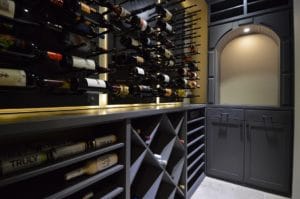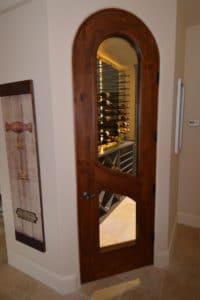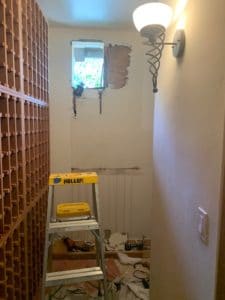
The team changed the entire racking with triple-deep black satin stain wine pegs to maximize the wine capacity of the wine cellar. A custom-made arch was also added for aesthetics.
Steve, a member of Wine Cellar Designers Group, did a wine cellar makeover for a client in Rancho Santa Fe, California. His main objective for the project was to optimize the cooling system and the insulation of the wine cellar. The owner was having problems with her wine cellar. The humidity and temperature within her wine cellar seemed inadequate; molds were growing fast in the cellar. She had tried replacing the cooling unit multiple times before. But none of them seemed to work. So she called Steve and asked for his expertise in building the best custom wine cellar for her.
The team discovered upon inspection of the wine cellar that the insulation and cooling system in the wine cellar was not sufficient. The former configuration of both the wine cellar and the cooling system was not working well together. With the client’s approval, Steve’s team decided to remodel the wine cellar and change the cooling system with something that can work well with the client’s wine room.
Don’t have any idea what’s the best way to optimize the humidity and temperature for your wine cellar? The expert members of the Wine Cellar Designers Group are here to help you. Read on and learn more about the basic concepts of cooling and insulation for your wine cellar.
What You Need to Know About the Right Cooling System for Your Wine Cellar
Maintaining the optimum humidity and temperature within your wine cellar sounds simple enough. Get a Wine Guardian or a Whisperkool cooling unit and have it installed. Problem solved, right? Well, not really. There’s more to storing and preserving your wine collection than you might think. You have to think holistically about how to tackle the cooling system of your custom wine cellar.
There are many factors you have to consider in order to maintain the optimum temperature and humidity within your wine cellar. Here some factors you should consider to get the most out of your cooling system.
The Total Area of Your Custom Wine Cellar
Cooling units have a maximum area that can be covered by their cooling and humidifying output. Using the cooling unit beyond that range won’t give you desired results. You’ll end up spending more but getting less from your cooling system. And the worst possible scenario is it’ll overwork your cooling system causing it to break down.
The R-Value in Your Wine Cellar
The R-Value is the capacity of an insulating material to resist heat flow. The higher the value, the better it is for your wine cellar. It pertains to all the insulating materials installed and constructed by your builder for your wine cellar. Making sure that there are no leaks or cracks in the wine cellar is also a significant factor for the R-value. A wine cellar with good R-Value is never affected by the fluctuating temperature and humidity outside the wine room. Maintaining good R values in your wine cellar means storing your wine collection in their optimum conditions. It also means that there’s less likelihood that your wine would have premature aging or spoilage.
We’ll Help You Find the Right Cooling Unit for Your Needs

Steve installed a double pane glass door with a self-sealing mechanism to seal the room, strengtening the insulation capacity of the room.
As mentioned above, knowing the specifications and capacity of your custom wine cellar will help us determine which cooling unit will function most effectively. With that taken into consideration, there are several options you have for your wine cooling system.
There are generally two main types of wine cellar cooling systems: the self-contained cooling unit and the split-system cooling unit. Each has its own features and benefits that could best suit your style and preference.
The self-contained cooling unit is both simple and easy to install. It has a vent that blows off air to the adjacent room or area from the wine cellar thru a ducting system or directly from the vent to the other room. It’s a bit noisy as compared with the split type cooling unit since the compressor is inside or within the proximity of the wine cellar. Maintenance could be a pain since you usually have to remove the unit (it’s sealed for warranty purposed) and ship it to the manufacturer.
The split type cooling unit produces minimal to no noise within the wine cellar. The condenser is separated from the central cooling unit. Copper tubing and electrical wirings connect the cooling unit to the condenser. It is advantageous since there will be minimal noise coming from the unit and no heat dissipating from the unit. The R-Value of any wine cellar is further increased because of this feature. It can be a bit more expensive than the traditional self-contained cooling unit. But it is much easier to maintain. Technicians can go to the site to have it repaired and checked for maintenance.
The Wine Cellar Renovation Project by Wine Cellar Designers Group

The self-contained cooling unit was replaced with a split type cooling unit that is more efficient and has less noise than the original cooling system.
The owner struggled with how to maintain the humidity and temperature in her wine cellar. The wine cellar never stayed cool. Her previously installed cooling system couldn’t support the optimum conditions for her wine cellar. If it continued, it could have compromised her vast wine collection.
Fortunately, Steve from Wine Cellar Designers Group was able to provide solutions to her problems. The team replaced the original racking with triple-deep black satin stain wine pegs. These pegs are exclusive creations by the Wine Cellar Designers Group. The back panel is Alder wood with an LED background to give emphasis to the wine collection.
Steve’s team installed a WhisperKOOL ceiling-mounted split type cooling unit. The condenser was placed outside. Lastly, a double pane glass door with a self-sealing mechanism was installed at the bottom part (to make sure there’s no leak or gap from the door).
The wine cellar now stays cool and there’s minimal noise inside the wine cellar. And, that’s another satisfied client under Steve’s belt.
Let Wine Cellar Designers Group Build the Perfect Custom Wine Cellar for YOU
Building your dream wine cellar could be challenging. But, with the right knowledge and a well-equipped builder, it shouldn’t be much of a problem. Wine Cellar Designers Group have more satisfied clients than they could count. Call us now and let’s build yours.

